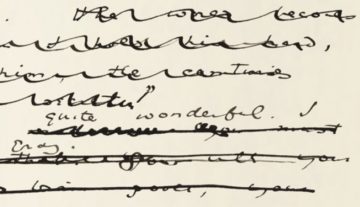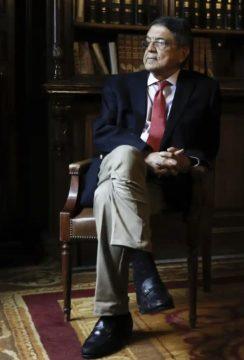Bruce Robbins at n+1:
 THE ARC THAT SAID HIMSELF gave to his life is not entirely reliable. He tells the story of withdrawing from Foucault and “the kind of anti-historical and starkly theoretical position I seemed to be advancing in Beginnings.” But James Clifford made it clear in an early review that Orientalism was already torn by conflicting commitments for as well as against humanism, and as Brennan notes, those conflicts are even apparent three years earlier in Beginnings itself. Indeed, at the very beginning of his career, when “Said was quickly becoming known as the apostle of ‘theory,’” Brennan declares that “the thought horrified him.” It makes little sense, then, to think of Said as riding the theory wave and then jumping off. What he got from theory’s reversal of text and critic was the conviction that “criticism, not necessarily fiction, was where the deepest cultural recesses of society were laid bare”—in other words, that the work of the critic mattered in the world and to the world. This commitment remained consistent throughout his career, whatever his take on Foucault and company, and it’s one reason why his fellow critics came to embrace him, despite political and theoretical differences.
THE ARC THAT SAID HIMSELF gave to his life is not entirely reliable. He tells the story of withdrawing from Foucault and “the kind of anti-historical and starkly theoretical position I seemed to be advancing in Beginnings.” But James Clifford made it clear in an early review that Orientalism was already torn by conflicting commitments for as well as against humanism, and as Brennan notes, those conflicts are even apparent three years earlier in Beginnings itself. Indeed, at the very beginning of his career, when “Said was quickly becoming known as the apostle of ‘theory,’” Brennan declares that “the thought horrified him.” It makes little sense, then, to think of Said as riding the theory wave and then jumping off. What he got from theory’s reversal of text and critic was the conviction that “criticism, not necessarily fiction, was where the deepest cultural recesses of society were laid bare”—in other words, that the work of the critic mattered in the world and to the world. This commitment remained consistent throughout his career, whatever his take on Foucault and company, and it’s one reason why his fellow critics came to embrace him, despite political and theoretical differences.
more here.

 We will be switching over to new servers today, Thursday, September 23, and this means we may not be able to post new items for a day or possibly longer. Thanks for your patience, and we’ll make the interruption as short as possible.
We will be switching over to new servers today, Thursday, September 23, and this means we may not be able to post new items for a day or possibly longer. Thanks for your patience, and we’ll make the interruption as short as possible. He died the day after Christmas. His loved ones washed and anointed his body and kept vigil at his bedside. “He looked like a king,” Jenifer told me. “He was really, really beautiful.” She showed me a few photos. His body had been laid atop a hemp shroud and covered from the neck down in a layer of dried herbs and flower petals. Bouquets of lavender and tree fronds wreathed his head, and a ladybug pendant on a beaded string lay across his brow like a diadem. Only his bearded face was exposed, wearing the peaceful, inscrutable expression of the dead. He did look like a king, or like a woodland deity out of Celtic mythology—his gauze-wrapped neck the only evidence of his life as a mortal.
He died the day after Christmas. His loved ones washed and anointed his body and kept vigil at his bedside. “He looked like a king,” Jenifer told me. “He was really, really beautiful.” She showed me a few photos. His body had been laid atop a hemp shroud and covered from the neck down in a layer of dried herbs and flower petals. Bouquets of lavender and tree fronds wreathed his head, and a ladybug pendant on a beaded string lay across his brow like a diadem. Only his bearded face was exposed, wearing the peaceful, inscrutable expression of the dead. He did look like a king, or like a woodland deity out of Celtic mythology—his gauze-wrapped neck the only evidence of his life as a mortal. The one thing you can say for sure about Katie Kitamura’s wonderfully sly new novel – the follow-up to her 2017 breakthrough A Separation, and one of Barack Obama’s summer reading picks – is that it offers a portrait of limbo. The unnamed narrator, a Japanese woman raised in Europe, has accepted a one-year contract as an interpreter at the International Criminal Court – identified only as “the Court” – in The Hague. The book’s title – which, like that of its predecessor, rejects the firmness of the definite article – refers to the relationship one might ideally have with language, spaces, customs, other people, one’s own emotions, the past. It’s unclear, at least at first, to what degree the character’s own failure to achieve this state herself is a product of temperament or circumstances – whether she is simply adjusting, or whether this is how she always presents, and negotiates, the world.
The one thing you can say for sure about Katie Kitamura’s wonderfully sly new novel – the follow-up to her 2017 breakthrough A Separation, and one of Barack Obama’s summer reading picks – is that it offers a portrait of limbo. The unnamed narrator, a Japanese woman raised in Europe, has accepted a one-year contract as an interpreter at the International Criminal Court – identified only as “the Court” – in The Hague. The book’s title – which, like that of its predecessor, rejects the firmness of the definite article – refers to the relationship one might ideally have with language, spaces, customs, other people, one’s own emotions, the past. It’s unclear, at least at first, to what degree the character’s own failure to achieve this state herself is a product of temperament or circumstances – whether she is simply adjusting, or whether this is how she always presents, and negotiates, the world. The historian Joe Moran begins his 2018 style guide, First You Write a Sentence, by outlining a comic routine unfortunately familiar to many of us:
The historian Joe Moran begins his 2018 style guide, First You Write a Sentence, by outlining a comic routine unfortunately familiar to many of us: Back in 2000, when
Back in 2000, when  I travelled to New York City in August for the first time since the pandemic began, to visit friends who had just bought their first home. They are firmly upper-middle class and in their 40s. They took out a mortgage for $1.5m (£1.1m) to buy a place in a Brooklyn neighbourhood that was regarded until recently as an area immune to gentrification. So far, so typical. Asset ownership comes late these days.
I travelled to New York City in August for the first time since the pandemic began, to visit friends who had just bought their first home. They are firmly upper-middle class and in their 40s. They took out a mortgage for $1.5m (£1.1m) to buy a place in a Brooklyn neighbourhood that was regarded until recently as an area immune to gentrification. So far, so typical. Asset ownership comes late these days. Rich in meaning and metaphor, the word ‘heart’ conjures up many images: a pump, courage, kindness, love, a suit in a deck of cards, a shape or the most important part of an object or matter. These days, it also brings to mind the global increase in heart attacks and cardiovascular damage that attends COVID-19. As a subject for a book, the heart is an organ with a lot going for it.
Rich in meaning and metaphor, the word ‘heart’ conjures up many images: a pump, courage, kindness, love, a suit in a deck of cards, a shape or the most important part of an object or matter. These days, it also brings to mind the global increase in heart attacks and cardiovascular damage that attends COVID-19. As a subject for a book, the heart is an organ with a lot going for it. What is found in a good conversation? It is certainly correct to say words—the more engagingly put, the better. But conversation also includes “eyes, smiles, the silences between the words,” as the Swedish author Annika Thor wrote. It is when those elements hum along together that we feel most deeply engaged with, and most connected to, our conversational partner, as if we are in sync with them. Like good conversationalists, neuroscientists at Dartmouth College have taken that idea and carried it to new places. As part of a series of studies on how two minds meet in real life, they reported surprising findings on the interplay of eye contact and the synchronization of neural activity between two people during conversation. In a paper published on September 14 in Proceedings of the Natural Academy of Sciences USA, the researchers suggest that being in tune with a conversational partner is good but that
What is found in a good conversation? It is certainly correct to say words—the more engagingly put, the better. But conversation also includes “eyes, smiles, the silences between the words,” as the Swedish author Annika Thor wrote. It is when those elements hum along together that we feel most deeply engaged with, and most connected to, our conversational partner, as if we are in sync with them. Like good conversationalists, neuroscientists at Dartmouth College have taken that idea and carried it to new places. As part of a series of studies on how two minds meet in real life, they reported surprising findings on the interplay of eye contact and the synchronization of neural activity between two people during conversation. In a paper published on September 14 in Proceedings of the Natural Academy of Sciences USA, the researchers suggest that being in tune with a conversational partner is good but that  On a December morning in 1947 when three fellows at Princeton’s Institute for Advanced Study set out for the Third Circuit Court in Trenton, it was decided that the job of making sure that the brilliant but naively innocent logician Kurt Gödel didn’t say something intemperate at his citizenship hearing would fall to Albert Einstein. Economist Oscar Morgenstern would drive, Einstein rode shotgun, and a nervous Gödel sat in the back. With squibs of low winter light, both wave and particle, dappled across the rattling windows of Morgenstern’s car, Einstein turned back and asked, “Now, Gödel, are you really well prepared for this examination?” There had been no doubt that the philosopher had adequately studied, but as to whether it was proper to be fully honest was another issue. Less than two centuries before, and the signatories of the U.S. Constitution had supposedly crafted a document defined by separation of powers and coequal government, checks and balances, action and reaction. “The science of politics,” wrote Alexander Hamilton in “Federalist Paper No. 9,” “has received great improvement,” though as Gödel discovered, clearly not perfection. With a completism that only a Teutonic logician was capable of, Gödel had carefully read the foundational documents of American political theory, he’d poured over the Federalist Papers and the Constitution, and he’d made an alarming discovery.
On a December morning in 1947 when three fellows at Princeton’s Institute for Advanced Study set out for the Third Circuit Court in Trenton, it was decided that the job of making sure that the brilliant but naively innocent logician Kurt Gödel didn’t say something intemperate at his citizenship hearing would fall to Albert Einstein. Economist Oscar Morgenstern would drive, Einstein rode shotgun, and a nervous Gödel sat in the back. With squibs of low winter light, both wave and particle, dappled across the rattling windows of Morgenstern’s car, Einstein turned back and asked, “Now, Gödel, are you really well prepared for this examination?” There had been no doubt that the philosopher had adequately studied, but as to whether it was proper to be fully honest was another issue. Less than two centuries before, and the signatories of the U.S. Constitution had supposedly crafted a document defined by separation of powers and coequal government, checks and balances, action and reaction. “The science of politics,” wrote Alexander Hamilton in “Federalist Paper No. 9,” “has received great improvement,” though as Gödel discovered, clearly not perfection. With a completism that only a Teutonic logician was capable of, Gödel had carefully read the foundational documents of American political theory, he’d poured over the Federalist Papers and the Constitution, and he’d made an alarming discovery. Testosterone’s wide-reaching effects occur not just in the human body, but across society, powering acts of aggression, violence, and the large disparity in their commission between men and women, according to Harvard human evolutionary biologist
Testosterone’s wide-reaching effects occur not just in the human body, but across society, powering acts of aggression, violence, and the large disparity in their commission between men and women, according to Harvard human evolutionary biologist  Sergio Ramírez, Nicaragua’s best-known living writer, hero of the Sandinista revolution, and former vice-president of the volcanic Central American nation, has lived through both tougher times and duller publicity tours.
Sergio Ramírez, Nicaragua’s best-known living writer, hero of the Sandinista revolution, and former vice-president of the volcanic Central American nation, has lived through both tougher times and duller publicity tours. A 3,600-year-old tablet showing part of the Epic of Gilgamesh will be formally handed back to
A 3,600-year-old tablet showing part of the Epic of Gilgamesh will be formally handed back to  Allison Draper loved anatomy class. As a first-year medical student at the University of Miami, she found the language clear, precise, functional. She could look up the Latin term for almost any body part and get an idea of where it was and what it did. The flexor carpi ulnaris, for instance, is a muscle in the forearm that bends the wrist — exactly as its name suggests. Then one day she looked up the pudendal nerve, which provides sensation to the vagina and vulva, or outer female genitalia. The term derived from the Latin verb pudere: to be ashamed. The shame nerve, Ms. Draper noted: “I was like, What? Excuse me?”
Allison Draper loved anatomy class. As a first-year medical student at the University of Miami, she found the language clear, precise, functional. She could look up the Latin term for almost any body part and get an idea of where it was and what it did. The flexor carpi ulnaris, for instance, is a muscle in the forearm that bends the wrist — exactly as its name suggests. Then one day she looked up the pudendal nerve, which provides sensation to the vagina and vulva, or outer female genitalia. The term derived from the Latin verb pudere: to be ashamed. The shame nerve, Ms. Draper noted: “I was like, What? Excuse me?”